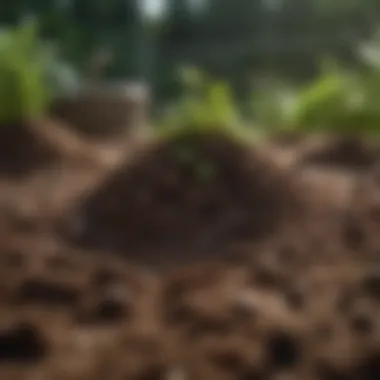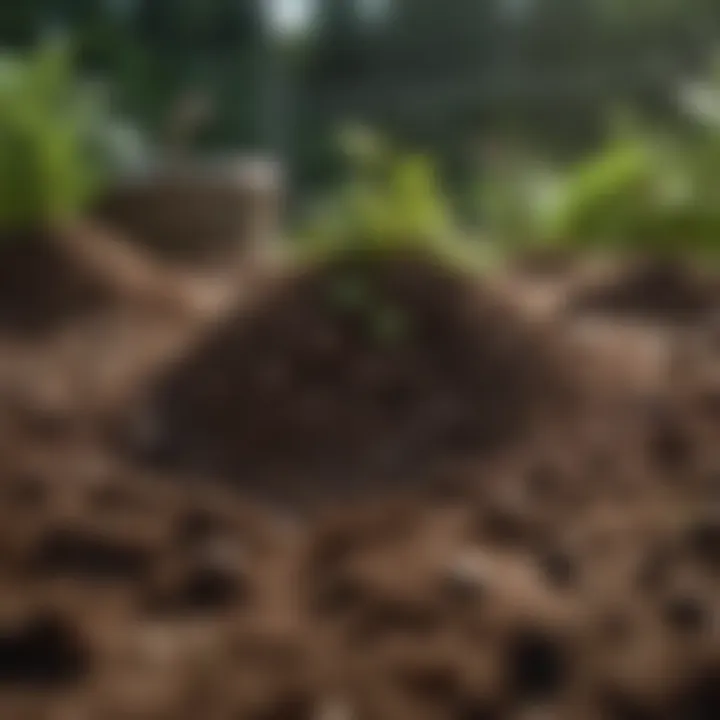Comprehensive Guide to Planting in the Backyard


Intro
Backyard planting is an essential consideration for homeowners. It can transform ordinary spaces into lush and productive gardens. A well-planned backyard is not just visually appealing; it can also yield fresh produce, enhance mental well-being, and support local biodiversity. This guide aims to equip readers with the necessary knowledge and skills to engage in successful planting initiatives.
From understanding the unique characteristics of soil and climate to selecting the right plants, every step is critical. Homeowners should carefully consider their available space and the specific requirements of the plants they wish to cultivate. Additionally, maintenance practices influence the long-term viability of any garden.
Design Inspiration
The design of your outdoor space can significantly enhance your planting experience. Recent trends in backyard landscaping emphasize creating functional areas that serve multiple purposes. This might include entertaining spaces, relaxation zones, or vegetable patches.
Current Trends in Gardening
Recent trends highlight an increased focus on sustainability and the use of native plants. Using native species can be beneficial because these plants are adapted to local climates and require less maintenance. Urban gardening has also gained popularity as people recognize the value of growing their food even in limited spaces.
Color Schemes and Palette Ideas
When selecting plants, consider how their colors will interact. Soft pastels may create a calming environment, while vibrant blooms can add energy. Plan your garden in a way that harmonizes these colors with your outdoor décor and the nature surrounding your home.
Gardening Techniques
Understanding various gardening techniques will greatly enhance your ability to cultivate a vibrant backyard. Each technique comes with its own unique advantages and requirements.
Plant Selection and Care
Choosing appropriate plants is essential for a flourishing garden. Factors such as growth habits, sunlight requirements, and water needs must be considered. Some plants are low-maintenance and thrive with minimal care, while others require regular attention.
"Researching which plants suit your climate and soil type can save time and effort in the long run."
Indoor vs. Outdoor Gardening
Deciding whether to plant indoors or outdoors also plays a significant role. Indoor gardening allows for a controlled environment, while outdoor gardening benefits from natural sunlight and pollinators. With indoor gardening, options such as container gardening or hydroponic systems are available, making it suitable for smaller spaces.
End
In closing, successful backyard planting relies on understanding plant needs, designing a functional space, and employing effective gardening techniques. Homeowners, with a little planning and effort, can create beautiful, productive gardens that enrich their lives and their communities.
Understanding Your Backyard Environment
Understanding your backyard environment is essential for successful planting. It lays the foundation for creating a thriving garden. Each backyard is unique, influenced by space dimensions, soil composition, and climatic conditions. By observing these elements, homeowners can make informed decisions. This ensures that the chosen plants will flourish in their specific environment.
Assessing Your Space
Measuring dimensions
Measuring the dimensions of your backyard is crucial. Accurate measurements help define the area available for gardening. This clarity aids in planning what plants to include. A well-measured space allows for effective layout designs that maximize growing potential. For example, knowing the square footage allows one to calculate planting density. This can prevent overcrowding, which can stifle plant growth. However, measuring can be tedious if the land is irregular. Yet, it's an important step in creating a successful garden.
Identifying sunlight patterns
Identifying sunlight patterns is another key aspect. Sunlight directly affects plant health and productivity. Observing how the sun moves across your space helps determine which areas are sunny or shady. Each plant has specific light requirements. Knowing these ensures proper placement in the garden. One advantage is that it allows for seasonal adjustments as sunlight changes over time. However, it may require continuous observation to accurately map changing sun angles throughout the year.
Recognizing drainage options
Recognizing drainage options in your backyard is crucial for plant health. Good drainage prevents water from pooling, which can lead to root rot. Evaluate the natural slope of your yard and identify low areas that may retain water. Implementing proper drainage solutions, like French drains, can help manage excess water. Safe drainage can support a healthier garden and avoid potential issues. While assessing drainage options may be less glamorous, it’s important for long-term plant vitality.
Soil Composition
Types of soil
Different types of soil impact plant growth significantly. Sandy, clay, and loamy soils each have unique characteristics. Sandy soil drains quickly, beneficial for plants that dislike excess moisture. Clay holds nutrients but can become compacted. Loamy soil is often ideal because it balances drainage and nutrient retention. Understanding soil types is key when choosing plants that will thrive in specific soil conditions. Each soil type has its advantages but may require different care techniques.
Testing soil quality
Testing soil quality is essential for an effective garden. Homeowners can determine pH levels and nutrient content through simple tests. Soil quality assessments direct plants' nutritional needs and help avoid deficiencies. Testing can inform amendments needed for improvement, such as adding lime or organic matter. A potential downside is that cost and effort may deter some from conducting regular tests. Nevertheless, it is a proactive approach to ensure successful planting.
Improving soil fertility
Improving soil fertility can transform a mediocre garden into a thriving one. Techniques include adding organic matter, compost, or fertilizers tailored to plant needs. Improving soil fertility enhances nutrient content and promotes robust plant growth. Regularly enriching the soil can yield better crops and flowers. The downside is that it requires ongoing effort and awareness of the specific needs of plants. Informed adjustments lead to long-term sustainability.
Climate Considerations
Hardiness zones
Understanding hardiness zones is indispensable for successful plant selection. These zones inform homeowners about which plants can survive in their climate. Each zone represents a range of temperature averages during winter. Selecting plants suited to a specific hardiness zone increases the likelihood of success. However, not all plants are labeled with this information, requiring additional research for planting decisions.
Seasonal weather changes
Seasonal weather changes impact the planning and maintenance of the garden. Gardeners must anticipate fluctuations in temperature and rainfall, affecting planting schedules. Understanding local climate patterns can prevent missteps in plant selection. Adjusting garden plans with these changes in mind ensures better resilience. However, it requires continuous monitoring and willingness to adapt, sometimes unpredictably.
Microclimates within the garden
Recognizing microclimates within your garden can enhance your gardening strategy. Microclimates are tiny areas that have their unique climatic conditions, often varying from the larger landscape. They may be influenced by structures, trees, or water features. Understanding these can help homeowners select plants that thrive in those specific patches. Though identifying microclimates can be complex, it allows for more tailored planting decisions.
In summary, understanding your backyard environment is the first crucial step to creating a successful garden. Knowing the layout, soil types, climate zones, and microclimates will empower you to make the best choices for your planting endeavors.
Selecting Appropriate Plants
Choosing the right plants is a fundamental step in crafting a successful backyard garden. This process requires a careful assessment of various factors, including the local environment, desired aesthetics, and practical use of the plants. The right selection can lead to a garden that thrives and enhances the outdoor space, while poor choices might result in wasted effort and resources. Before planting, consider what functions the plants will serve, whether for beauty, food production, or both.
Understanding Plant Categories
Annuals vs. perennials
Annuals and perennials represent two distinct growth categories vital for any garden. Annuals are plants that complete their life cycle in a single year. They are often vibrant and can add immediate color and beauty to your backyard. Many gardeners appreciate them because of their broad range of colors and styles. In contrast, perennials return each year, developing a root system that lasts longer. This characteristic makes perennials a sustainable choice, often needing less maintenance over time. However, some perennials take time to establish before they bloom, delaying gratification for a garden owner.
Herbs and vegetables
Herbs and vegetables are crucial for both culinary uses and aesthetics. Growing your own produce can be rewarding and helps ensure access to fresh ingredients. The primary characteristic of herbs is their aromatic properties, and they can often enhance the flavor of many dishes. On the other hand, vegetables contribute substantially to nutrition. Planting a diverse selection allows gardeners to enjoy variety throughout the growing season. They could, however, require specific growing conditions and maintenance practices to yield productive results.
Ornamental plants
Ornamental plants focus on beauty rather than utility, making them a staple in many gardens. These plants can transform a space into a visually appealing area. They can be chosen based on color, texture, and overall design effect. Ornamental plants offer a wide range of forms, from flowering shrubs to decorative grasses. However, it is essential to choose varieties that can thrive in the local climate and conditions to avoid potential disappointments.
Native vs. Non-native Species
Benefits of native plants
Native plants are those that naturally occur in a specific region. An advantage of planting native species is their adaptability to the local climate and soil. These plants typically require less water and are often more resistant to pests and diseases. This can result in lower maintenance costs and efforts. Additionally, native plants support local wildlife, such as pollinators, making them a eco-friendly option.
Challenges with non-native species
While non-native plants may offer appealing features and may seem attractive, they can prove challenging. These plants might struggle to adapt to the local environment. Non-native species can often require additional care, such as more water or pest control measures. In some cases, they can outcompete native flora, leading to ecological imbalances.
Ecological impacts
The decision to choose between native and non-native species has broad ecological implications. Native plants contribute to biodiversity and soil health. They support native insects and animals, promoting a healthier ecosystem. Conversely, non-native species can disrupt local flora and fauna, leading to diminished biodiversity. This consideration is critical for any sustainable gardening approach.


Companion Planting Strategies
Enhancing growth
Companion planting is a technique that involves putting together plant species that can benefit each other. Some plants provide shade or support, while others might attract beneficial insects. The practice can lead to increased growth and productivity. For instance, planting tomatoes alongside basil can enhance flavors and deter pests. This synergy can create a healthier garden environment overall.
Pest deterrence
Certain plants are known for their pest-repellent properties. Marigolds, for example, can deter nematodes and other common pests. Planting these around more vulnerable species can provide a natural defense. Utilizing pest deterrent plants fits well into organic gardening practices and reduces the reliance on chemical pesticides.
Maximizing space efficiency
Companion planting allows gardeners to make the most of limited space. By selecting the right plants that grow well together, vertical planting can be utilized. Tall plants can provide shade for shorter ones, or deep-rooted plants can access nutrients below the surface while shallow-rooted types can thrive on the surface. This maximization not only increases yield but enhances the overall aesthetic appeal of the garden.
Designing Your Backyard Garden
Designing your backyard garden is a critical aspect of successful planting. A well-thought-out design leads to a visually appealing and functional space. It allows homeowners to maximize their garden's productivity and aesthetic value. The key elements of garden design include layout, focal points, and pathways. Each plays a significant role in usability and overall enjoyment of the garden. Careful planning can yield a space that not only serves its purpose but also fulfills your vision for your outdoors.
Layout Planning
The layout of your garden establishes the foundation for your planting endeavors. Consideration in layout planning can influence plant health, ease of maintenance, and visual harmony. There are several common approaches to layout, including grid design, curved design, and zoning for various plant types.
Grid layout
Grid layout provides a structured and orderly approach to garden design. It consists of straight lines forming squares or rectangles, allowing for clear division of space. This method contributes significantly to efficient space management. A primary characteristic of grid layouts is their simplicity, making this option a popular choice. It helps in maximizing sunlight exposure and promoting easier access for maintenance. A potential drawback is that it may lack visual variety compared to more organic shapes.
Curved design
Curved design emphasizes fluidity and natural beauty. It introduces gentle arcs and rounded forms that can create a softer look in the garden. This element can enhance the aesthetic value of your space. The characteristic of curved design is its ability to guide viewers’ eyes smoothly through the landscape. This design approach can create areas that feel inviting and relaxing. However, maintaining a curved design requires careful planning and might need more work to implement effectively.
Zoning for different plant types
Zoning for different plant types involves organizing your garden based on the specific needs of each plant species. This structure helps cater to plants' varying needs, such as sunlight, water, and soil requirements. The key characteristic of zoning is its focus on plant compatibility and health. This organization is beneficial in fostering a thriving ecosystem within the garden. It can present challenges in terms of initial planning. Yet, once established, it leads to a more sustainable and vibrant garden.
Creating Focal Points
Focal points are an essential element in garden design, adding interest and structure. They can guide viewers’ attention and enhance the visual impact of the space. Common focal points include water features, sculptures, and distinctive plant arrangements.
Water features
Incorporating water features into your garden can create a serene environment. They introduce soothing sounds and attract wildlife, enhancing biodiversity. The key characteristic of water features is their ability to provide a tranquil setting. They are a popular choice for anyone looking to enhance relaxation in their garden. However, maintaining a water feature requires commitment and could add to the overall upkeep.
Sculptures and art
Sculptures and art pieces enrich your garden’s aesthetic appeal. They can convey personal style and create conversation starters. The unique feature of including sculptures is their ability to serve as focal points, breaking up the greenery. Integrating art adds a layer of creativity to the design. However, the choice of materials and installation can require careful consideration to ensure durability and alignment with the garden theme.
Distinct plant arrangements
Distinct plant arrangements focus on the variety and placement of plants for visual impact. By grouping plants with contrasting textures and colors, this design approach can create stunning displays. This arrangement provides a dynamic quality to the garden. It allows for creative expression while enhancing plant health through proper spacing. The challenge lies in the upfront planning to achieve balance and coherence in the design.
Incorporating Pathways
Pathways are vital in any garden design, guiding movement through the space. They enhance accessibility and contribute to the overall organization of the garden. Effective pathway design involves planning access routes, choosing appropriate materials, and ensuring functionality.
Designing access routes
Designing access routes is crucial for creating a user-friendly garden space. Clear paths invite exploration and ensure easy access to various areas. A key characteristic of well-designed access routes is their ability to connect different focal points within the garden. This enhances flow and provides a logical direction for navigation. A drawback might be the complexity involved in planning wider paths for larger gardens.
Materials for pathways
The choice of materials for pathways significantly impacts both aesthetics and functionality. Common options include gravel, stone, wood, and pavers. The key characteristic of good pathway materials is their durability and slip resistance. Some materials, like gravel, are affordable and easy to install. However, they may require more maintenance compared to solid options like stone or pavers, which can be more costly upfront.
Ensuring functionality
Ensuring functionality in garden design involves considering both form and purpose. The pathways must accommodate foot traffic while maintaining ease of access to plants. A key quality of functional pathways is their ability to lead users in a direct manner without obstruction. While pursuing aesthetics, it is essential to prioritize usability. Neglecting functionality can hinder the enjoyment of your garden layout.
Planting Techniques
Planting techniques play a crucial role in developing a vibrant backyard garden. These methods influence not only how plants are established but also their growth and productivity. Understanding effective planting techniques allows homeowners to maximize their garden's potential while addressing challenges that may arise. By implementing sound techniques, you can foster an environment conducive to healthy plant development, which ultimately leads to a thriving space.
Timing Your Planting
Timing your planting can have a significant impact on the success of your garden. Each season presents unique conditions suitable for different types of plants. Choosing the correct time to plant enhances the likelihood of strong root systems and healthy growth.
Spring planting
Spring planting is often recommended because it aligns with the natural growth cycle of many plants. The weather begins to warm up, and longer days provide ample daylight for photosynthesis. In this article, spring planting is beneficial as it allows homeowners to take advantage of the entire growing season ahead.
A notable feature of spring planting is the diversity of plant options available. Many vegetables, herbs, and flowering plants flourish when planted in spring. However, it is important to consider local frost dates, as late frosts can affect young plants negatively.
Fall strategies
Fall strategies involve planting in the cooler months as temperatures begin to drop. This method can be advantageous for certain species, particularly perennials. Fall planting allows roots to establish before winter, which can result in stronger plants in spring.
An important characteristic of fall planting is its flexibility. This method can permit the planting of bulbs and other plants that require colder temperatures to thrive. Nevertheless, gardeners must be cautious about harsh winter conditions that can threaten young plants.
Seasonal adjustments
Seasonal adjustments refer to modifying planting techniques and timing based on specific climate conditions. Adapting to these variations helps maintain a successful garden year-round. Understanding weather patterns and soil conditions is vital when planning for each season.
A key benefit of seasonal adjustments is the ability to optimize plant performance during unexpected weather changes. Whether it is unseasonably warm temperatures or unusual rainfall, being adaptable can mitigate risks involved in gardening. On the flip side, regular adjustments may require extra planning and attentiveness.
Preparation Steps
Effective preparation steps lay the groundwork for successful planting. The effort put into preparing the space directly reflects the potential health and productivity of the plants.
Clearing the area
Clearing the area is a foundational step in preparing for planting. This process involves removing debris, old plants, and any obstacles that could hinder growth. A clean area reduces competition for resources and promotes better air circulation.
The primary characteristic of clearing the area is creating a fresh start for new plants. This step is beneficial as it minimizes disease risk and soil imbalances that could harm new growth. However, it can be labor-intensive and may require tools and some physical effort.
Tilling the soil
Tilling the soil is another essential preparation step. This process aerates the ground, allowing for better water retention and root penetration. Tilling also helps to break up hard clumps of soil, making it easier for young plants to establish themselves.
The significant advantage of tilling is its capacity to mix in organic matter. This is vital for improving soil fertility. However, over-tilling can lead to soil degradation, and therefore, it is important to strike a balance in this practice.
Adding organic matter
Adding organic matter enriches the soil and fosters a healthier garden ecosystem. Materials such as compost or well-rotted manure provide important nutrients and improve soil structure. Additionally, organic matter promotes beneficial microbial activity within the soil.
A unique feature of adding organic matter is its sustainability. This approach supports ongoing soil health and fertility while minimizing the need for synthetic fertilizers. While highly beneficial, it may require time to decompose properly before significantly impacting the soil.
Proper Planting Depths
Understanding proper planting depths is fundamental to ensuring plant systems develop correctly. Different plants require specific depths to thrive, impacting their long-term health and stability.


Guidelines for root systems
Guidelines for root systems dictate how deep plants should be placed into the soil. Most plants need to be positioned so that their root crowns are level with the soil surface. This is essential for establishing a strong foundation.
This aspect is important as proper planting depth helps avoid potential issues like root rot. Improper depth may also hinder growth or lead to plant slumping. Therefore, following guidelines ensures optimal plant health and performance.
Avoiding transplant shock
Avoiding transplant shock is crucial, especially when moving seedlings or established plants. Shock can occur when plants experience stress due to disruption of their root systems. Proper depth and care in handling play a significant role in minimizing this risk.
A critical benefit of careful planting is promoting smoother transitions for plants into their new environments. When plants are adequately placed, they adapt more readily to their surroundings. However, transplanting during extreme weather can still pose challenges to mitigating shock.
Spacing considerations
Spacing considerations relate to how far apart seeds and plants should be placed from one another. Appropriate spacing is vital for ensuring proper air circulation and access to nutrients. It also prevents overcrowding, which can lead to competition among plants for essentials.
The key characteristic of spacing is its influence on overall garden aesthetics and productivity. Optimum spacing allows individual plants to thrive. However, too much space can lead to areas of underutilization in your garden layout. Striking the right balance permits healthy growth and maximizes yield.
Care and Maintenance
Care and maintenance play a crucial role in ensuring a thriving backyard garden. Effective care not only extends the lifespan of plants but also enhances their growth and productivity. It is vital to consistently monitor plants' needs, which vary through the seasons.
Proper care and maintenance include regular watering, fertilization, and pest management. Each of these elements is interconnected. For example, understanding the soil and watering needs ensures that plants receive the right nutrients in the correct amounts. This guide provides insights into the various aspects of garden maintenance, allowing homeowners to cultivate a vibrant space.
Watering Techniques
Irrigation systems
Irrigation systems are a significant part of garden maintenance. They automate the watering process, ensuring plants receive adequate moisture. One key characteristic of irrigation systems is their efficiency. They supply water evenly, which often results in healthier plants. Drip irrigation, for example, delivers water directly to the roots, reducing waste and evaporation. However, an initial investment and installation complexity can be disadvantages that some homeowners may consider.
Manual watering tips
Manual watering presents a more hands-on approach. It allows gardeners to engage directly with their plants. A notable advantage of manual watering is the ability to observe plants closely for signs of distress. This can lead to early detection of issues. Using a watering can or hose, it’s essential to water early in the day or late in the evening to minimize evaporation. However, this method can be time-consuming for larger gardens.
Water conservation strategies
Water conservation strategies are becoming increasingly important, especially in areas prone to drought. Techniques such as mulching and rainwater harvesting help maintain soil moisture. Highlighting water conservation as beneficial exemplifies responsible gardening practices. Utilizing greywater or drip systems can significantly lower water usage. That said, awareness of local regulations regarding water use is necessary to avoid legal complications.
Fertilization Practices
Organic vs. synthetic fertilizers
Fertilizers are critical for soil enrichment. Organic fertilizers are derived from natural sources, promoting sustainable gardening practices. They improve soil structure and support microbial life, which is a crucial aspect of healthy gardens. In contrast, synthetic fertilizers act quickly, offering immediate nutrient availability. However, over-dependence on them can lead to soil degradation and potential environmental harm. Therefore, finding a balance is essential.
Understanding NPK ratios
Understanding NPK ratios is vital for effective fertilization. NPK refers to the three key nutrients: nitrogen (N), phosphorus (P), and potassium (K). These nutrients serve different functions; nitrogen promotes leaf growth, phosphorus supports root and flower development, and potassium boosts overall plant health. Using the correct ratio according to plant needs can optimize growth, yet misapplication may result in nutrient burn or deficiency.
Application methods
Application methods vary widely, each suited to different fertilizer types. Broadcasting is a common method, where fertilizers are spread evenly over the soil. For liquid fertilizers, diluting and applying with a sprayer ensures even coverage. A unique feature is the slow-release granules, which provide nutrients gradually. However, improper application can lead to nutrient leaching, diminishing effectiveness.
Pest Management
Identifying common pests
Identifying common pests is the first step in effective pest management. Recognizing the signs of trouble early can minimize damage to plants. Key characteristics of many pests, such as discoloration or holes in leaves, signal infestations. This initial awareness empowers gardeners to take action swiftly. Failure to identify these pests can lead to larger issues and more costly interventions.
Natural pest deterrents
Natural pest deterrents offer an environmentally friendly approach to pest control. Essential oils, neem oil, and diatomaceous earth can effectively ward off unwanted insects. Their main advantage is minimal impact on beneficial organisms in the garden. But, some natural options might require frequent applications to maintain their effectiveness compared to synthetic alternatives.
Integrated pest management systems
Integrated pest management systems take a holistic approach to pest control. This method combines cultural, biological, and chemical strategies. Understanding its principles can help gardeners establish long-term solutions. By targeting the root causes of infestations, this strategy reduces dependency on pesticides. Nevertheless, it requires ongoing monitoring and a good understanding of local ecology to implement effectively.
Seasonal Maintenance Tasks
Seasonal maintenance tasks are vital in ensuring the health and productivity of your backyard garden. Performing these tasks at the appropriate times fosters an environment for growth, helps manage pests, and prepares the garden for changing seasons. Understanding the importance of these tasks can significantly enhance your gardening experience and yield.
Spring Clean-Up
Removing debris
Removing debris is the first step in spring clean-up. It involves clearing away dead leaves, branches, and other organic materials that accumulate over the winter. The key characteristic of this task is that it prevents disease and pest infestations that may arise if decomposing materials are left. This makes it a beneficial choice since a clean garden bed promotes better air circulation and light exposure.
The unique feature of removing debris lies in its simplicity. Clearing away the clutter can drastically improve the appearance and health of your garden space without requiring extensive gardening knowledge. However, disadvantages may arise if debris is not sorted properly. For instance, some materials can be composted while others may harbor pests or diseases.
Pruning and trimming
Pruning and trimming involve selectively cutting away dead or overgrown branches. This practice encourages healthy growth and shapes plants effectively. The key characteristic here is its impact on plant productivity; pruning stimulates new growth and can enhance blooming in flowering plants. This makes it a popular choice for gardeners looking to maximize their yield.
The unique feature is that it allows for better light penetration and air circulation within dense plantings. If done correctly, pruning can result in vibrant plants. However, excessive pruning can lead to stress and hinder growth, so one must balance the extent of cutting.
Soil amendments
Soil amendments are critical for improving soil fertility and structure. Adding organic matter, such as compost or well-rotted manure, enhances nutrient content and improves water retention. The key characteristic of this task is its long-term benefit; amending soil leads to healthier plants and more robust growth.
One unique aspect of soil amendments is the variety of materials available, which allows gardeners to tailor their approach based on soil needs. Like any technique, soil amendments have their downsides, such as the potential for nutrient imbalances if over-applied. Thus, testing the soil before making amendments is highly recommended.
Summer Care
Mulching benefits
Mulching during summer serves multiple purposes, such as weed control, moisture retention, and temperature regulation. The key characteristic of mulching is its ability to create a stable environment conducive to healthy plant growth. This makes mulching a beneficial choice for maintaining garden health during hot months.
Mulching's unique feature is its versatility; materials range from organic options like straw or wood chips to synthetic barriers. However, over-mulching can lead to fungal issues or hinder moisture absorption, which can be disadvantageous in certain conditions.
Regular monitoring
Regular monitoring of plants and soil conditions is crucial, particularly during the growing season. It involves checking for signs of pests, diseases, or nutrient deficiencies. The essence of this task lies in its proactive nature; by catching issues early, you can prevent larger problems later. This makes regular monitoring a popular choice among vigilant gardeners.
The unique feature of monitoring is that it provides real-time feedback on plant health, allowing you to make timely decisions. However, it does require consistent effort, which can be a challenge for some gardeners.
Adjusting watering practices
Adjusting watering practices based on seasonal demands is essential to prevent over or under-watering. The key characteristic of this task is its dynamic nature; it requires one to be aware of changing weather and plant needs. This aspect helps maintain optimal growth conditions, making it a beneficial choice in gardening.
A unique aspect is the various methods available for watering, from drip irrigation to hand-watering. Each method has its pros and cons, though over-watering can lead to root rot, emphasizing the need for careful management.
Fall Preparations
Harvesting crops
Harvesting crops at the right time is crucial for optimal flavor and yield. The key characteristic is that it allows you to enjoy the fruits of your labor while also preventing overripening. This makes harvesting an enjoyable and essential task in the gardening process.
The unique feature of harvesting is that it requires knowledge of each plant's maturity indicators, such as color or firmness. However, improper timing can result in loss of plant quality and missed opportunities for peak flavor.


Preparing plants for winter
Preparing plants for winter involves various techniques, such as mulching and wrapping sensitive plants. The key characteristic is its role in protecting plants from harsh temperatures. This makes winter preparation a beneficial practice for sustaining plant life.
One unique aspect is the variety of methods available, from using burlap covers to deeper mulch layers. While beneficial, preparing plants poorly can lead to frost damage, so careful planning is vital.
Soil tests for fall
Conducting soil tests in fall is critical for assessing nutrient levels before winter. The key characteristic is the detailed insight these tests provide, enabling targeted amendments to enhance soil quality. This makes soil testing a wise choice for long-term gardening success.
The unique feature lies in the actionable data gathered, which can inform future planting and amendments. However, interpreting soil test results can be complex, and neglecting this step may lead to unaddressed soil issues.
Common Challenges in Backyard Planting
Backyard planting is not without its difficulties, which can hinder the success of your gardening efforts. Understanding the common challenges ensures better preparation and more fruitful outcomes. Challenges such as poor soil quality, weed overgrowth, and climate change can adversely impact plant growth and overall garden health. In this section, those challenges will be examined in detail.
Dealing with Poor Soil Quality
Identifying soil issues
Identifying soil issues is crucial to ensure a thriving garden. Poor soil can manifest as compacted earth, lack of nutrients, or improper pH levels. Testing your soil helps to pinpoint deficiencies and assess its structure. Soil health is integral to plant vitality, and understanding its composition can lead to more targeted interventions. This aspect serves homeowners who wish to maximize their planting area.
The key characteristic here is the ability to analyze and take corrective measures.
Remediating soil deficiencies
Remediating soil deficiencies is another essential task. Once you identify what your soil lacks, you can amend it using organic matter like compost or minerals like lime. Adding these amendments improves nutrient availability and enhances soil structure. It is a popular technique among gardeners who seek to revitalize worn-out ground. Carefully selecting the right amendments fosters a balance that can lead to more robust plant growth. The unique feature is the improvement in overall plant health after remediation, although it takes time and consistency.
Choosing resilient plants
Choosing resilient plants can mitigate some of the issues caused by poor soil conditions. Native species or hardy varieties can adapt better to less-than-ideal soil environments. They require less care and can often survive on lower nutrient levels. This choice is beneficial as it promotes biodiversity and requires less intervention. By choosing the right plants, the overall effort can be reduced. However, considering the right plants demands understanding your climate and soil, which can be a disadvantage if these elements are not well-researched.
Controlling Weeds
Weed identification
Weed identification contributes significantly to effective garden management. Recognizing weeds enables you to act sooner before they take over your garden. Common weeds can compete for nutrients and water, ultimately strangling your desired plants. Failing to identify weeds quickly can lead to larger problems. The key feature is the varied types of weeds that present unique challenges, demanding different removal methods. Proper identification allows for tailored strategies suited to specific species.
Prevention strategies
Prevention strategies focus on creating conditions that limit weed growth. Techniques such as mulching, planting ground cover, or regular cultivation can significantly reduce weed populations. Using landscape fabric or barriers provides mechanical protection. Employing these methods is popular among gardeners as it establishes a proactive approach rather than reactive harm control. These unique features often lead to long-term success in weed management, although they require initial effort and investment.
Safe removal methods
Safe removal methods are crucial for maintaining garden health. Utilizing hand-pulling or biodegradable weed killers minimizes environmental impact while safeguarding your plants. These methods focus on ensuring a non-toxic approach to weed control. The key characteristic is the ability to protect existing plants while effectively dealing with unwanted species.
While safe methods can be slower, they promote overall garden health and sustainability.
Adapting to Climate Changes
Understanding climate impact
Understanding climate impact is crucial for sustainable gardening practices. Awareness of changing weather patterns guides plant selection and planting techniques. Gardens in areas facing drastic temperature changes may require specific strategies to ensure plant survival. The key aspect is how gardeners adapt to these shifts, leading to better moisture retention and temperature regulation in the garden. Knowing these impacts can empower gardeners to make informed decisions. While such adaptation requires time, the ultimate resilience in gardens can outweigh initial efforts.
Adapting plant choices
Adapting plant choices to suit a changing climate is another vital strategy. Choosing varieties that thrive in specific conditions ensures a successful garden. This often means selecting plants with drought resistance or heat tolerance. The flexibility in this choice can give gardeners an edge, allowing them to overcome challenges imposed by shifting climates. However, the downside may involve sometimes extensive research.
Long-term sustainability plans
Long-term sustainability plans are essential to ensure future gardening success. Developing a strategy that includes conserving resources and allowing for crop rotation can foster a resilient garden over time. This approach promotes biodiversity while reducing dependency on external inputs. The importance of sustainability in gardening is gaining momentum, making it a wise choice among progressive gardeners. The unique feature here is that successful plans often require a commitment to understanding and adjusting to environmental changes.
"Understanding your garden's needs must align with the surrounding environment for optimal growth and sustainability."
Resources for Further Learning
In the context of backyard planting, continuing education plays a pivotal role. Resources for further learning empower individuals to expand their knowledge and refine their gardening practices. Knowledge does not end after setting up a garden. Instead, it is an ongoing journey. Thus, having a variety of resources can significantly enhance one’s gardening skills, leading to better outcomes.
Books and Publications
Recommended gardening books
Gardening books are a fundamental resource that provides comprehensive insight into various aspects of planting. They often cover everything from basic planting techniques to advanced horticultural science. A well-written gardening book, like The New Organic Garden, focuses on practical information and sustainable practices. This book is a popular choice because it offers a complete overview of organic gardening principles, covering seed selection, pest management, and seasonal practices.
Furthermore, gardening books enable readers to learn at their own pace. Unique features might include illustrations and step-by-step guides, making it easier to visualize the concepts discussed. Though they can be dense, their detailed nature allows for deeper understanding and assurance in one’s gardening endeavors.
Journals and magazines
Gardening journals and magazines are valuable for their regular updates and community insights. Publications such as Fine Gardening or Gardens Illustrated provide articles written by experts, showcasing trends, tips, and horticultural breakthroughs. These resources can keep readers informed about the latest techniques and plant varieties. A key characteristic of these publications is their real-time information, which can lead to immediate application in the garden.
The downside is that subscription costs can accumulate over time. However, the benefits of current and diverse information often outweigh the costs, making them an effective learning tool for gardeners eager to stay informed.
Online resources
Online resources, such as gardening websites and blogs, provide a dynamic platform for learning. Websites like Garden.org offer forums, articles, and videos that cater to various gardening levels. This accessibility makes them a beneficial choice for tech-savvy individuals who thrive on information diversity. One unique feature is the interactive community aspect, allowing gardeners to ask questions and receive answers in real-time.
However, the vastness of online information can sometimes be overwhelming. Not all content is reliable, so it is crucial for readers to evaluate the credibility of sources. Despite this challenge, online resources are invaluable for ongoing education, offering immediate knowledge when needed.
Local Gardening Clubs and Workshops
Benefits of joining clubs
Local gardening clubs provide a community for gardeners to share experiences and ideas. The social aspect is a key characteristic, promoting camaraderie among members passionate about gardening. Clubs may organize events featuring guest speakers or garden tours, which creates learning opportunities in a relaxed environment. This support network can be particularly beneficial for new gardeners, who may feel lost navigating the multitude of gardening choices.
While the benefits of joining clubs are clear, there could be occasional time constraints for busy individuals. Nevertheless, being part of a gardening community adds a rich layer to the gardening experience, enhancing both learning and enjoyment.
Networking opportunities
Networking in gardening circles fosters relationships that can lead to mutual growth. Local clubs often connect passionate gardeners who can share insights, tips, and even seeds. A key characteristic of these networks is the development of trust-based relationships. When members share their achievements and setbacks, others can learn through these experiences, which is invaluable.
However, it is important to note that while networking offers many opportunities, participating may require effort in attending meetings and events. Ultimately, these connections can lead to lasting friendships and increased knowledge, which are critical for any dedicated gardener.
Skill development workshops
Skill development workshops can take the gardening experience to the next level. These hands-on experiences allow participants to apply theoretical knowledge in real-world scenarios. Workshops may focus on specific skills, such as pruning techniques or pest control methods, enhancing both understanding and proficiency. This format encourages active learning, making it easy to grasp challenging concepts.
One advantage is that these workshops often feature expert guidance, which can accelerate understanding. However, availability can vary by location, and some may require fees. Nonetheless, these workshops are worthwhile investments for serious gardeners seeking to elevate their skills to new heights.
Online Forums and Communities
Engaging with other gardeners
Engaging with other gardeners through online forums provides a unique platform for sharing knowledge. Communities like the r/gardening subreddit enable gardeners to ask questions, share experiences, and seek advice from peers. This interaction is essential for self-improvement and can foster friendships based on common interests. A key benefit here is the wide range of perspectives and solutions presented, which can stimulate new ideas for individual projects.
The downside is that online discussions can sometimes be diluted with too much information. However, the benefits of engaging with fellow enthusiasts often outweigh this drawback, as the collective knowledge can spark innovative solutions.
Sharing experiences and knowledge
Sharing experiences and knowledge through online platforms enables gardeners to learn from each other’s successes and failures. Users can post pictures, ask for advice, and receive feedback on various gardening issues, making the process collaborative. This feature is highly beneficial, as it provides a real-time exchange of information relevant to current gardening seasons or challenges.
While the nature of online communication can lead to misunderstandings or misinterpretations, the strong community foundation usually helps mitigate such issues. Overall, sharing knowledge fosters a culture of continuous learning, vital for both new and seasoned gardeners.
Crowdsourcing advice
Crowdsourcing advice from online communities allows individuals to tap into a wealth of experiences. Platforms like Facebook groups or gardening forums encourage members to seek input on unique problems. This process can yield valuable insights, as diverse opinions often lead to innovative solutions. A key characteristic of crowdsourced advice is the variety of approaches to similar issues, enhancing problem-solving skills.
Nonetheless, not all advice may be sound, and it is crucial for individual gardeners to use discernment when evaluating suggestions. Despite this potential pitfall, crowdsourcing remains a powerful tool, expanding the gardener’s toolset to tackle diverse challenges.



